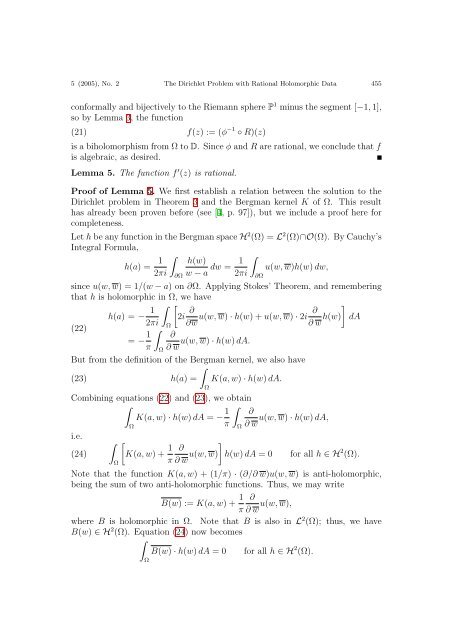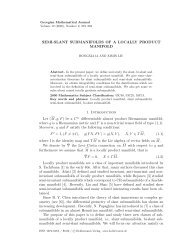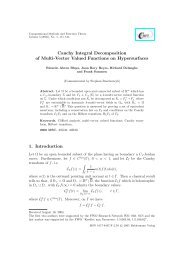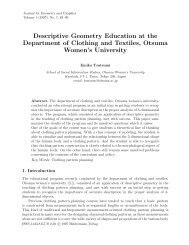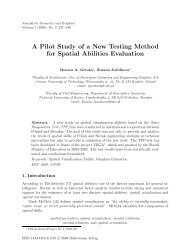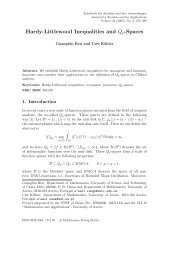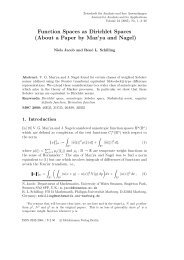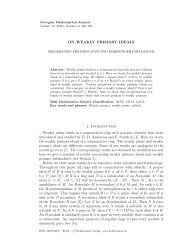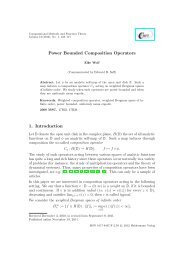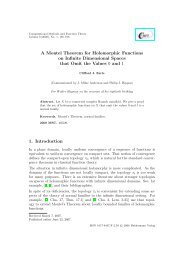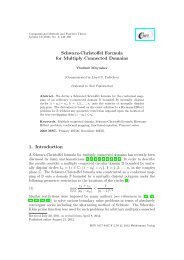On the Solution of the Dirichlet Problem with Rational Holomorphic ...
On the Solution of the Dirichlet Problem with Rational Holomorphic ...
On the Solution of the Dirichlet Problem with Rational Holomorphic ...
You also want an ePaper? Increase the reach of your titles
YUMPU automatically turns print PDFs into web optimized ePapers that Google loves.
5 (2005), No. 2 The <strong>Dirichlet</strong> <strong>Problem</strong> <strong>with</strong> <strong>Rational</strong> <strong>Holomorphic</strong> Data 455<br />
conformally and bijectively to <strong>the</strong> Riemann sphere P 1 minus <strong>the</strong> segment [−1, 1],<br />
so by Lemma 3, <strong>the</strong> function<br />
(21) f(z) := (φ −1 ◦ R)(z)<br />
is a biholomorphism from Ω to D. Since φ and R are rational, we conclude that f<br />
is algebraic, as desired.<br />
Lemma 5. The function f ′ (z) is rational.<br />
Pro<strong>of</strong> <strong>of</strong> Lemma 5. We first establish a relation between <strong>the</strong> solution to <strong>the</strong><br />
<strong>Dirichlet</strong> problem in Theorem 3 and <strong>the</strong> Bergman kernel K <strong>of</strong> Ω. This result<br />
has already been proven before (see [4, p. 97]), but we include a pro<strong>of</strong> here for<br />
completeness.<br />
Let h be any function in <strong>the</strong> Bergman space H 2 (Ω) = L 2 (Ω)∩O(Ω). By Cauchy’s<br />
Integral Formula,<br />
h(a) = 1 ∫<br />
h(w)<br />
2πi ∂Ω w − a dw = 1 ∫<br />
u(w, w)h(w) dw,<br />
2πi ∂Ω<br />
since u(w, w) = 1/(w − a) on ∂Ω. Applying Stokes’ Theorem, and remembering<br />
that h is holomorphic in Ω, we have<br />
h(a) = − 1 ∫ [<br />
2i ∂<br />
]<br />
∂<br />
u(w, w) · h(w) + u(w, w) · 2i<br />
2πi Ω ∂w ∂ w h(w) dA<br />
(22)<br />
= − 1 ∫<br />
∂<br />
u(w, w) · h(w) dA.<br />
π Ω ∂ w<br />
But from <strong>the</strong> definition <strong>of</strong> <strong>the</strong> Bergman kernel, we also have<br />
∫<br />
(23) h(a) = K(a, w) · h(w) dA.<br />
Ω<br />
Combining equations (22) and (23), we obtain<br />
∫<br />
K(a, w) · h(w) dA = − 1 ∫<br />
∂<br />
u(w, w) · h(w) dA,<br />
Ω π Ω ∂ w<br />
i.e.<br />
∫ [<br />
(24) K(a, w) + 1 ]<br />
∂<br />
π ∂ w u(w, w) h(w) dA = 0 for all h ∈ H 2 (Ω).<br />
Ω<br />
Note that <strong>the</strong> function K(a, w) + (1/π) · (∂/∂ w)u(w, w) is anti-holomorphic,<br />
being <strong>the</strong> sum <strong>of</strong> two anti-holomorphic functions. Thus, we may write<br />
B(w) := K(a, w) + 1 ∂<br />
u(w, w),<br />
π ∂ w<br />
where B is holomorphic in Ω. Note that B is also in L 2 (Ω); thus, we have<br />
B(w) ∈ H 2 (Ω). Equation (24) now becomes<br />
∫<br />
B(w) · h(w) dA = 0 for all h ∈ H 2 (Ω).<br />
Ω


